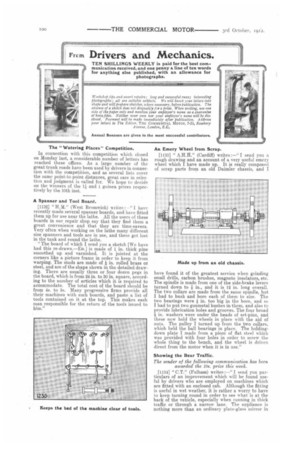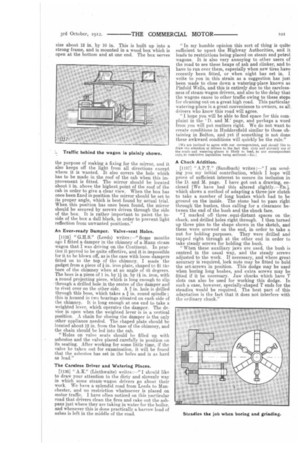Frc m Drivers and Mechanics.
Page 20

Page 21

If you've noticed an error in this article please click here to report it so we can fix it.
TEN SHILLINGS WEEKLY is paid for the best cornmunicat ion received, and one penny a line of ten words for anything else published, with an allowance for photographs.
'Workshop tips and smart repairs; long and successful runs; interesting photographs ; All are suitable subjects. We will knock your letters into shape and will PrePare sketches, where necessary, before Publication. The absence of a sketch does not disqualify for a Prise. When tell iting, use one Side of the paper only and mention your ensPloyer's name as a guarantee of bona fides. Neither your own nor your employer's nante will be disclosed, Payment will be made immediately after Publication. Address your letters to The Editor, THE COMMERCIAL MOTOR, 7-15, Rosebery Avenue, London, EC.
The "Watering Places" Competition.
In connection with this competition which closed on Monday last, a, considerable number of letters has reached these offices. As a large number of the great trunk roads have been used by drivers in connection with the competition, and as several lists cover the same point-to-point distances, great care in selec tion and judgment is called for. We hope to decide on the winners of the 11 and I guinea prizes respectively by the 10th inst.
A Spanner and Tool Board.
[1132] " H.M." (West Bromwich) writes :—" I have recently made several spanner boards, and have fitted them up for use near the lathe. All the users of these boards in our repair shop say that they find them a great convenience and that they are time-savers. Very often when working on the lathe many different size spanners and tools are in use, and these get lost in the tank and round the lathe.
"The board of which I send you a sketch [We have had this re-drawn.—En.] is made of 1 in. thick pine smoothed up and varnished. It is jointed at the corners like a picture frame in order to keep it from warping. The studs are made of in. rolled brass or steel, and are of the shape shown in the detailed drawing. There are usually three or four dozen pegs in the board, which is from 24 in. to 30 in. square, accord-. jug to the number of articles which it is required to accommodate. The total cost of the board should be from 4s. to 5s. Many progressive firms provide all their machines with such boards, and paste a list of tools contained on it at the top. This makes each man responsible for the return of the tools issued to him." An Emery Wheel from Scrap.
[1133] " (Cardiff) writes :—" I send you a rough drawing and an account of a very useful emery wheel which I have made up. It is really composed of scrap parts from an old Daimler chassis, and I have found it of the greatest service when grinding small drills, carbon brushes, magneto insulators, etc. The spindle is made from one of the side-brake levers turned down to in., and it is 12 in. long overall. The two collars are made from the same spindle, but I had to bush and bore each of them to size. The two bearings were in. too big in the bore, and so I had to put two gunmetal bushes in them, and also to provide lubrication holes and grooves. The four broad in. washers were under the heads of set-pins, and these now hold the wheels in place with the aid of nuts. The pulley I turned up from the two collars, which held the ball bearings in place. The holdingdown plate I made from a piece of flat steel which was provided with four holes in order to screw the whole thing to the bench, and the wheel is driven direct from the motor when it is in use."
Showing the Rear Traffic.
The sender of the following communication has been awarded the los. prize this week.
[1134] "CT" (Fulham) writes :—" I send you particulars of an improvement which will be found useful by drivers who are employed on machines which are fitted with an enclosed cab. Although the fitting is useful in wet weather, it is rather a worry to have to keep turning round in order to see what is at the back of the vehicle, especially when running in thick traffic or through a narrow lane. The anpliance is nothing more than an ordinary plate-glass mirror in size about 12 in. by 10 in. This is built up into a strong frame, and is mounted in a wood box which is open at the bottom and at one end. The box serves the purpose of making a fixing for the mirror, and it also keeps off the light from all directions except where it is wanted. It also covers the hole which has to be made in the roof of the cab when this improvement is fitted. The mirror should be located about 3 in. above the highest point of the roof of the cab in order to give a clear view. When the box has once been fixed in position the mirror should be set to its proper angle, which is best found by actual trial. When this position has once been found, the mirror should be secured by screws driven through the side of the box. It is rather important to paint the inside of the box a dull black, in order to prevent light reflection from unwanted positions."
An Ever-ready Damper. Valve-seat Holes.
[1135] " G.H.S." (Leeds) writes:—" Some months ago I fitted a damper in the chimney of a Mann steam wagon that I was driving on the Continent. In practice it proved to be quite effective, and it is impossible for it to be blown off, as is the case with loose dampers fitted on to the top of the chimney. I made the gadget from a piece of in. iron plate, shaped to flu the bore of the chimney when at an angle of 45 degrees. The boss is a piece of 1 in. by 14 in. by 14 in. iron, with a round projecting piece, which is long enough to slip through a drilled hole in the centre of the damper and to rivet over on the other side. A in. hole is drilled through this boss, which takes a I in. round spindle ; this is housed in two bearings situated on each side of the chimney. It is long enough at one end to take a weighted lever, which operates the damper. The device is open when the weighted lever is in a vertical position. A chain for closing the damper is the only other appliance needed. The shaped plate should be located about 12 in. from the base of the chimney, and the chain should be led into the cab.
"Holes on valve seats should be filled up with asbestos and the valve placed carefully in position on its seating. After working for some little time, if the valve be taken out for examination, it will be found that the asbestos has set in the holes and is as hard as lead."
The Careless Driver and Watering Places.
[1136] " A.K." (Linthwaite) writes :—" I should like to draw your attention to the dirty and slovenly way in which some steam-wagon drivers go about their work. We have a splendid road from Leeds to Man chester, and no restriction whatsoever is placed on motor traffic. I have often noticed on this particular road that drivers clean the fires and rake out the ashpans just where they are taking in water for the boiler. and whenever this is done practically a barrow-load of ashes is left in the middle of the road. In my humble opinion this sort of thing is quite sufficient to upset the Highway Authorities, and it leads to restrictions being placed on steam and petrol wagons. It is also very annoying to other users of the road to see these heaps of ash and clinker, and to have to run over them, especially when new tires have recently been fitted, or when night has set in. I write to you in this strain as a suggestion has just been made to close down a watering-place known as Pinfold Wells, and this is entirely due to the Carelessness of steam-wagon drivers, and also to the delay that the wagons cause to other traffic owing to these stops for cleaning out on a great high road. This particular watering-place is a great convenience to owners, as all drivers who know this road will agree.
"I hope you will be able to find space for this complaint in the 'D. and M.' page, and perhaps a word from you will put matters right. We do not want to create conditions in Huddersfield similar to those obtaining in Bolton, and yet if something is not done these awkward conditions will quickly be the rule."
I We are inclined to agree with our correspondent, and should like to draw the attention of drivers to the fact that dirty and slovenly use Of the roads and watering-plaaes is likely to lead, as our correspondent ,lys, to restrictive legislation being enforced.—Eu.1 A Chuck Addition.
[1137] " A.P.T." (Sandbach) writes:—" I am sending you my initial contribution, which I hope will prove of sufficient interest to secure its inclusion in the D. and M. page. I have got out a drawing, enclosed [We have had this altered slightly.—En.], which shows a method of adapting a three-jaw clutch to take a number of long bushes which had to be ground on the inside. The stone had to pass right through the bushes, thus calling for a clearance between the end of the bush and the chuck face.
"I marked of three . equi-distant spaces on the. chuck, and drilled holes right through. I then turned up three pins to the shape shown in the sketch, and these were screwed on the end, in order to take a nut for holding purposes. They were drilled and tapped right through at the other end in order to take steady screws for holding the bush. "When these auxiliary jaws are used, the bush is centred in the usual way, and the steady screws adjusted to .the work. If necessary, and where great accuracy is required, lock nuts may be fitted to hold the set-screws in position. This dodge may be used when boring long bushes, and extra screws may be fitted if it be necessary. Jaw chucks which have T slots can also be used for working this dodge. In such a case, however, specially-shaped T ends for the steadies would be required. The best part of this adaptation is the fact that it does not interfere with the ordinary chuck."






















